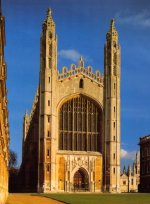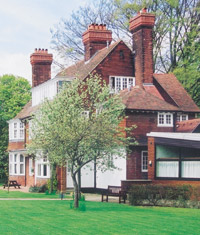Part A
CAMBRIDGE -- THE UNIVERSITY TOWN
When we say that Cambridge is a university town we do not mean just that it is a town with a university in it. Some other cities also have universities in them, but we do not call them university towns. A university town is one where there is no clear separation between the university building and rest of the city. The university is not just one part of the town; it is all over the town. The heart of Cambridge has its shops, pubs, market place and son on, but most of it is university -- colleges, faculties, libraries, clubs and other places for university staff and students. Students fill the shops, cafes, banks and churches, making these as well part of the university.
The town was there first. Two Roman roads crossed there, and there are signs buildings before Roman times (earlier than AD 43). Later Cambridgr became a center of learning, and the authority of the head of the university was recognised by the king in 1226

King's College Chaptel in the lovely university of Cambridge.
At that time many of the students were very young (about fifteen), and many of teachers were not more than twenty-one. At first they found lodgings where they could, but many student were too poor to afford lodging. Colleges were opened so that students could live cheaply. This was the begining of the college system which hs continued at Cambridge up to the present day.
The colleges were built with money from kings, queens, religious houses or other sources. Today there are nearly thirty colleges. The newest are University College, founded in 1965, and Clare Hall, founded in 1966. Very few students can now live in college for the whole of their course; the numbers are too great. Many of them live in lodging at first and move into college for their final year. But every student is a member of his college from the begining. each week. His social and sports life centers on the college, although he will also join various university societies and clubs. To make this clearer, take the imaginary case of John Smith.

Clare Hall
He is an undergraduate at Queen's College. His rooms are on E staircase, not far from his tutor's rooms on C staircase. He has dinner in the fine old college hall four times a week. He plays football for Queen's and hopes to be chosen to play for the university this yaer. His other favourite sport is boxing, and he is a member of the university club. He is 'reading' history, and goes once a week to Emmanuel College to see his supervisor to discuss his work and his lectures. He belongs to serveral university societies-- the Union, the Historical Society, a photographic club, and son on -- and to a number of college societies.
With about 8,250 undergraduates like JohnSmith and over 2,000postgraduates, the city is a busy place in 'full term'. Undergraduates are not allowed to keep cars in Cambriade, so nearly all of them use bicycles. Don't try to drive through Cambridge during the five minutes between lectures. On Mondays John Smith has a lecture in one college ending at 9:55 and another in a different college at 10. His bicycle must get him there through a boiling sea of other bicycles hurrying in all directions. If you are in Cambridge at five minutes to the hour any morning of full term. you know that you are in a university town. Stop in some safe place, and wait.
|